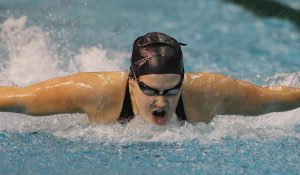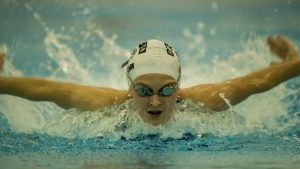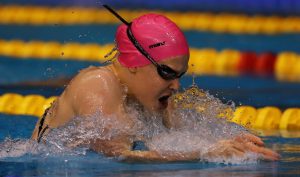Sport Rehabilitation and Physiotherapy for Swimmers
 Swimming is a fantastic sport and an incredibly popular low-impact fitness activity which combines strength, flexibility and endurance. The term swimming encompasses a wide range of distances from pool sprinting to long distance open water events. Over 2.5 million people swim weekly in the UK and the most popular swimming stroke is front crawl. Elite swimmers can train more than five miles a day which puts joints through extreme repetitive motion. Although there are a variety of different distances and strokes the injuries sustained are very similar in nature. Most swimming injuries affect the shoulders, knees, hips, or back, depending on stroke. The common injuries are usually due to the repetitive stresses placed on the musculoskeletal system and 90% of injuries are to the shoulder.
Swimming is a fantastic sport and an incredibly popular low-impact fitness activity which combines strength, flexibility and endurance. The term swimming encompasses a wide range of distances from pool sprinting to long distance open water events. Over 2.5 million people swim weekly in the UK and the most popular swimming stroke is front crawl. Elite swimmers can train more than five miles a day which puts joints through extreme repetitive motion. Although there are a variety of different distances and strokes the injuries sustained are very similar in nature. Most swimming injuries affect the shoulders, knees, hips, or back, depending on stroke. The common injuries are usually due to the repetitive stresses placed on the musculoskeletal system and 90% of injuries are to the shoulder.
At Metro, we have a significant amount of experience in assessing and treating both amateurs and professionals and have provided treatment for a wide variety of swimming abilities.
Common Swimming Injuries
 Swimming is a repetitive sport and with overuse comes fatigue and failure to adhere to correct stroke techniques. Often swimmers demonstrate tremendous flexibility and may have joint laxity. Slight injuries and micro-trauma can cause shoulders to become unstable and lead to shoulder pain and tendinitis. Other repetitive injuries include inner knee and hip problems from breaststroke kicking and back injuries from dolphin kicks or dry-land cross-training
Swimming is a repetitive sport and with overuse comes fatigue and failure to adhere to correct stroke techniques. Often swimmers demonstrate tremendous flexibility and may have joint laxity. Slight injuries and micro-trauma can cause shoulders to become unstable and lead to shoulder pain and tendinitis. Other repetitive injuries include inner knee and hip problems from breaststroke kicking and back injuries from dolphin kicks or dry-land cross-training
Swimmer’s Shoulder
The shoulder is the joint most commonly affected joint and injuries may include shoulder impingement, rotator cuff tears, biceps tendinitis and shoulder instability. These injuries can occur because the structures that surround the shoulder joint do not work to maintain the ball within its socket. This is likely to be due to fatigue and weakness of the rotator cuff and muscles surrounding the shoulder blade.
Lower Body Injuries
Knee injuries that involve the tendons and ligaments (breaststrokers’ knee) are common. Breaststrokers may also experience hip pain from inflammation of the hip tendons. Back problems including disc injuries or a problem at the junction between the spine and pelvis termed spondylolysis. This can be caused by the dolphin kick often used in competitive swimming.
Reducing the risk of Swimming injuries
 Prevention is key!
Prevention is key!
Evidence suggests that injury management should focus on prevention and early treatment, addressing the impairments associated with the condition, and analysing training methods and stroke mechanics. (Tovin, 2006.)
A large part of managing an injury involves communication between parents, coaches and therapist to enhance recovery and prevent injury.
Your training regime should consist of a mixture of stretching, strengthening and conditioning exercises as well as the sport-specific training required for your event to help reduce the risk of injury. Tight, inelastic muscles can be a contributing factor to injury and therefore if you notice that your muscles groups are tightening up, the use of a foam-roller and deep tissue sports massage can help to ease that tension. Muscle imbalances and poor stability can also lead to injury, therefore if you notice you have weak muscle groups or are unsteady on one leg compared to the other, it is worth getting checked out to address these issues before they lead to injury.
Treatments following a Swimming Injury
Most of our therapists are involved in sports themselves and so we are fully aware of the pressures associated with training for an event and being fit to compete. Alongside treatment our therapists are able to give guidance on when to return to training and alternative training strategies. Correct technique is vital in all swimming strokes and injuries often occur when there are movement fault patterns or when a particular muscle group is over-trained. A thorough assessment of the Athlete’s biomechanics and an understanding of the demands of the event help to formulate our treatment plan to ensure optimal recovery.
Treatment sessions will be tailored towards the individual and the injury, but will typically consist of some of the following techniques; deep tissue massage, deep frictional massage, trigger point release, interferential therapy, joint mobilisations, fascial release, Ultrasound Therapy, acupuncture, proprioceptive neuromuscular facilitation, taping/strapping and a specific tailored exercise programme.
